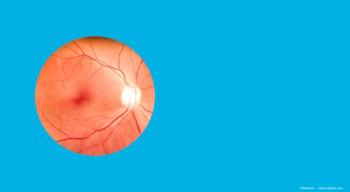
Moxifloxacin-soaked IOLs provide clinically relevant doses of antibiotic
A hydrophilic IOL (Afinity CQ2015, STAAR Surgical) seems to be a more efficient delivery system of moxifloxacin 0.5% (Vigamox, Alcon Laboratories) than a hydrophobic IOL (AcrySof SA60, Alcon Laboratories), according to the results of a comparison of lenses soaked in the antibiotic. Both lenses appear to be capable of delivering antibiotics to achieve clinically relevant levels, however.
Key Points
Fort Lauderdale, FL-Implantation of a hydrophilic acrylic IOL seems to be more efficacious in delivering moxifloxacin hydrochloride ophthalmic solution 0.5% (Vigamox, Alcon Laboratories) than a hydrophobic IOL, Edward F. Smith, MD, reported at the annual meeting of the Association for Research in Vision and Ophthalmology. Both lenses appear to be capable of delivering antibiotics to achieve clinically relevant levels, however.
Development of endophthalmitis is a dreaded, albeit rare, complication of cataract surgery, he said, adding that lowering the incidence of endophthalmitis by implantation of an IOL soaked in an antibiotic would be a boon to patients and surgeons.
Dr. Smith, who is clinical associate professor, SUNY Downstate Department of Ophthalmology, SUNY Downstate Medical Center, Brooklyn, NY, said that although precautions-such as sterile preoperative preparation, including isolation of lids and lashes; application of topical povidone-iodine; and administration of preoperative and postoperative topical antibiotics-are taken, they can be insufficient for preventing the development of endophthalmitis postoperatively.
In light of this finding, he and his colleagues conducted a study to determine the levels of moxifloxacin reached in an artificial anterior chamber after soaking a hydrophobic acrylic IOL (AcrySof SA60, Alcon Laboratories) and a hydrophilic collamer IOL (Afinity CQ2015, STAAR Surgical) in commercially available moxifloxacin 0.5%.
The investigators soaked the IOLs for either 1 or 10 minutes.
Ten of each of the IOLs were soaked in antibiotic for 1 minute, and another 10 of each IOL were soaked for 10 minutes. After soaking, the IOLs were placed on absorbent pads (BD Bioscience) for 10 seconds on each side to allow absorption of the excess drug. The IOLs then were placed in vials containing 10 ml of balanced salt solution for 30 minutes, after which 5 ml of BSS from each vial was sampled, frozen, and subjected to high-performance liquid chromatography analysis to determine the antibiotic levels.
The authors found that following the 1-minute period of soaking in moxifloxacin, no significant difference was seen in the moxifloxacin levels achieved between the two IOL types, (hydrophobic, 0.238 µg/ml; hydrophilic, 0.283 µg/ml).
After the 10-minute period of soaking, there were higher antibiotic levels for both types of IOLs.
"The increase in the antibiotic level was statistically significant for the hydrophilic IOL (0.717 µg/ml, p < 0.02), but it was not statistically significant for the hydrophobic IOL (0.342 µg/ml, p > 0.4). The moxifloxacin level in the hydrophilic IOL was not significantly higher than for the hydrophobic IOL (p > 0.05). There is a trend that suggested higher levels of moxifloxacin resulting from use of the hydrophilic IOL, [but] the difference was not significant for either the 1-minute or 10-minute soaking periods," Dr. Smith said.
Importantly, soaking IOLs in moxifloxacin as prophylaxis against endophthalmitis resulted in levels of antibiotic that exceeded the MIC90 of the most common pathogens responsible for the development of endophthalmitis postoperatively, and a longer period of soaking for the hydrophobic IOL did not result in a significant increase in the moxifloxacin levels.
"The high lipophilicity of moxifloxacin interacting with the hydrophobicity of the hydrophobic lens may be responsible for the similar antibiotic levels at both soak times," he said. "While we did not investigate the exact cause, previous theories have included the ideas that a short soaking time allows easier antibiotic release or that initial affinity may be higher while a longer soak yields a lower, steady-state concentration."
A noteworthy finding of the study was that when compared with previous studies in which IOLs were soaked for 1 to 24 hours, "the positive results from the 1-minute soaking time are important because this may be incorporated into the cataract extraction protocol," Dr. Smith emphasized.
In this study, although the hydrophilic IOL seemed to be a more efficient delivery system than the hydrophobic lens, "both lenses can deliver clinically relevant antibiotic levels after a 1-minute soak," he said.
"The moxifloxacin concentrations at both the 1-minute and 10-minute soak times exceeded the MIC90 of the most common pathogens responsible for the development of endophthalmitis postoperatively, namely, S epidermidis (0.13 µg/ml), S aureus (0.06 µg/ml), and Haemophilus influenzae (0.06 µg/ml). Levels from the 10-minute soak of the hydrophobic IOL and both time periods for the hydrophilic IOL also exceeded the MIC90 for Streptococcus spp (0.25 µg/ml) and Proteus mirabilis (0.25 µg/ml)," Dr. Smith added.
"Current prophylaxis practice includes isolation of the eyelids and lashes, application of topical povidone-iodine, and preoperative and postoperative topical antibiotics. The antibiotic-soaked IOL has potential to become a clinically relevant technique for preventing the development of endophthalmitis postoperatively," he concluded.
Newsletter
Don’t miss out—get Ophthalmology Times updates on the latest clinical advancements and expert interviews, straight to your inbox.



















































.png)


